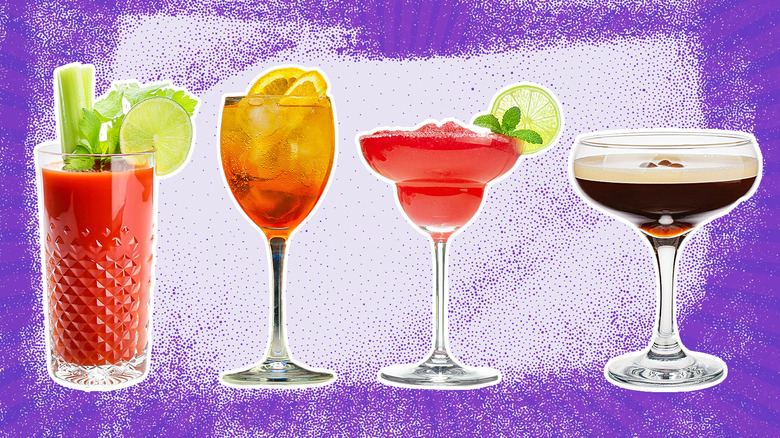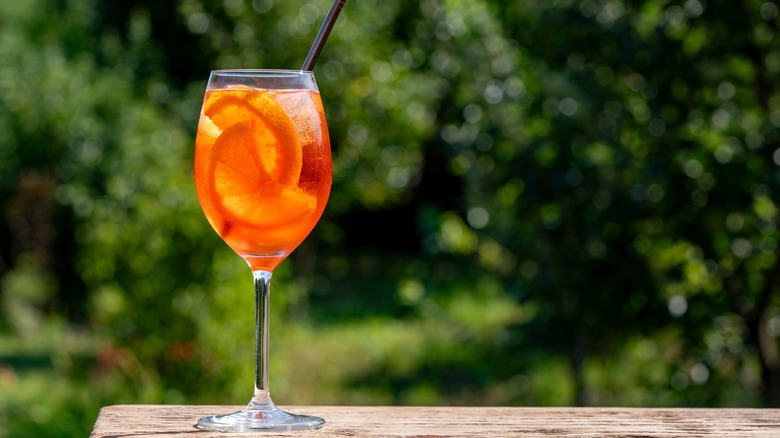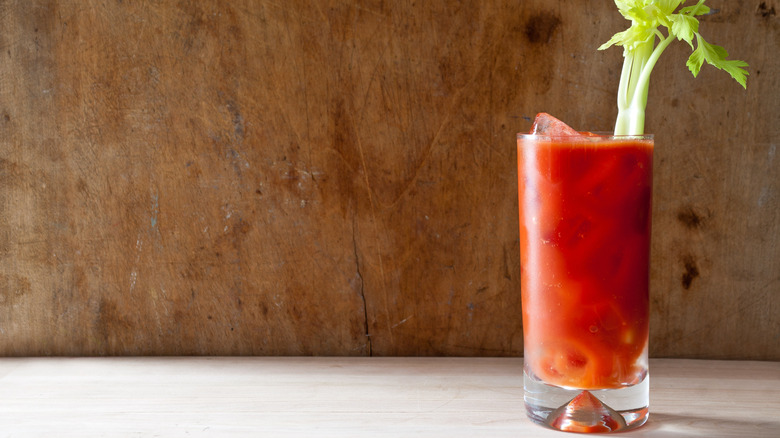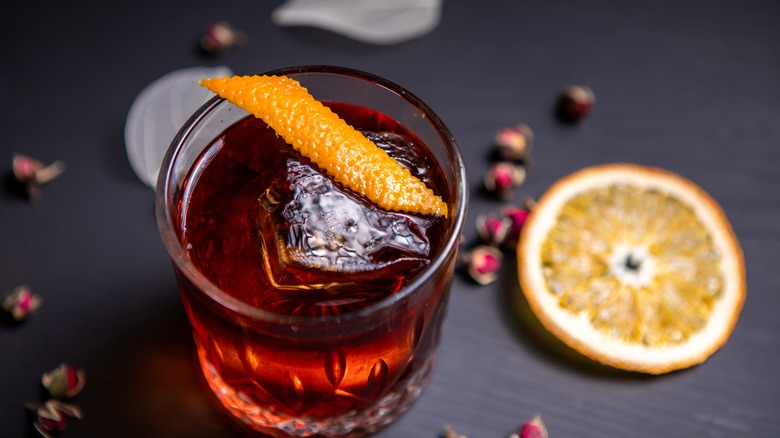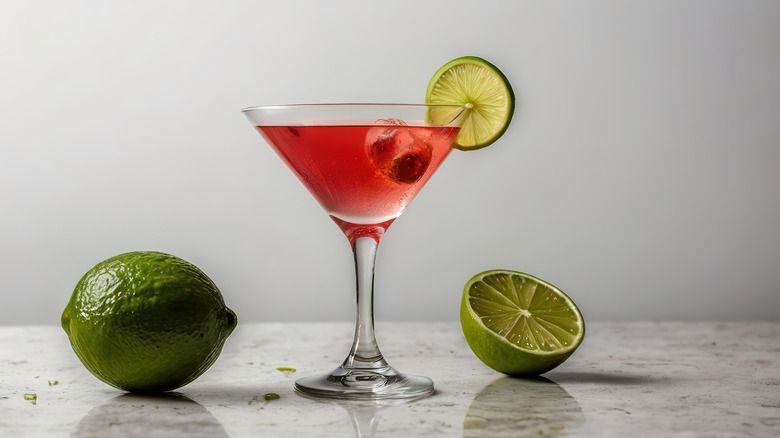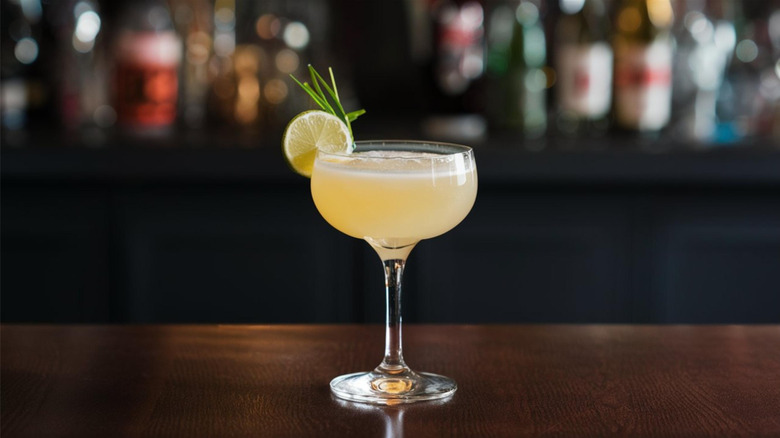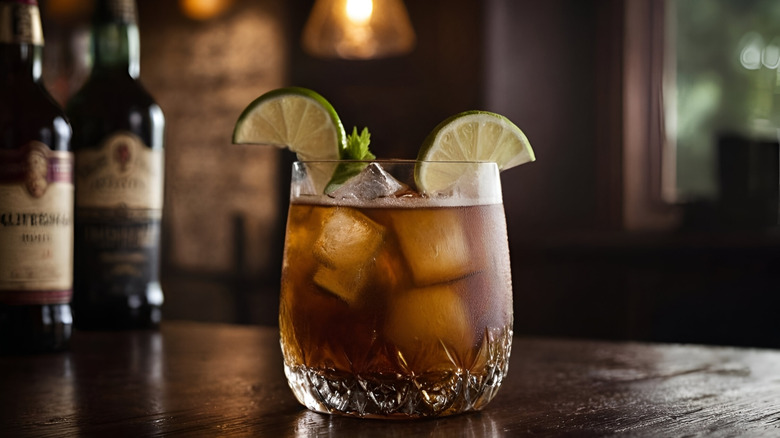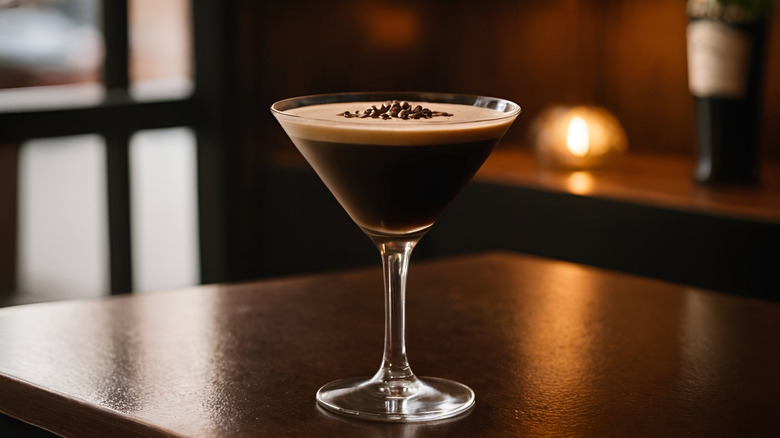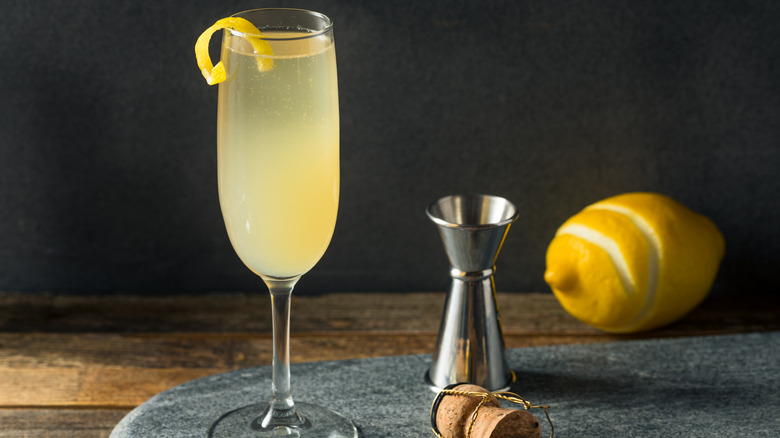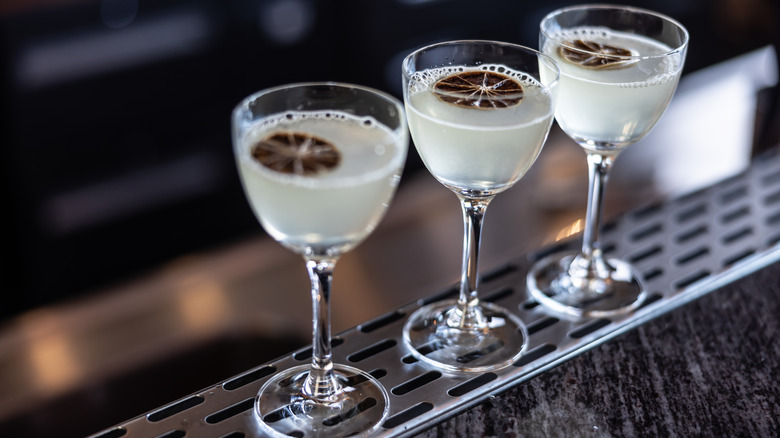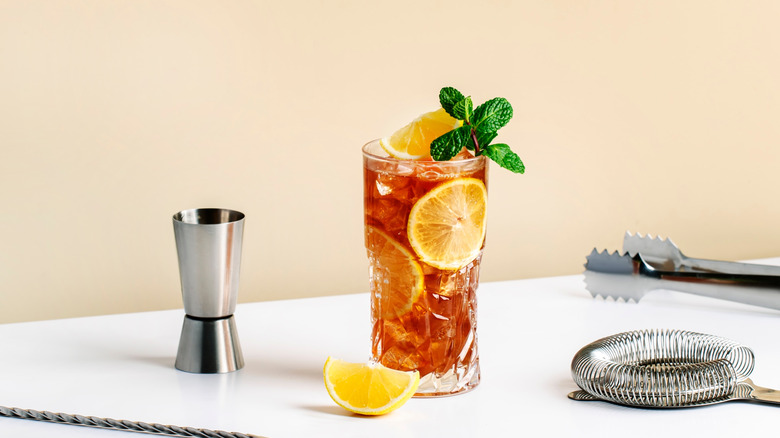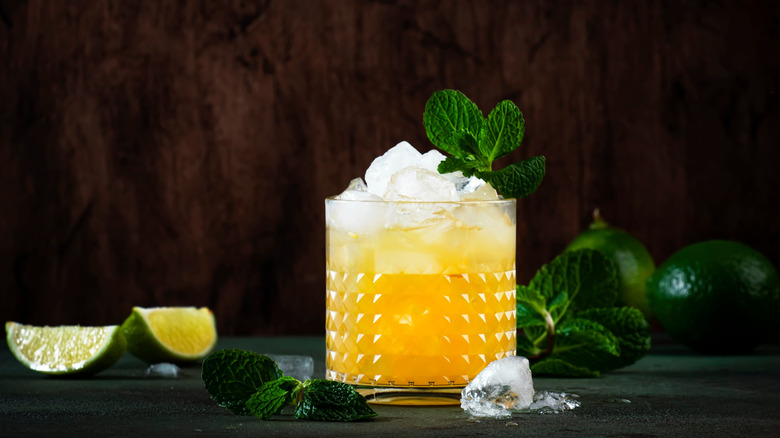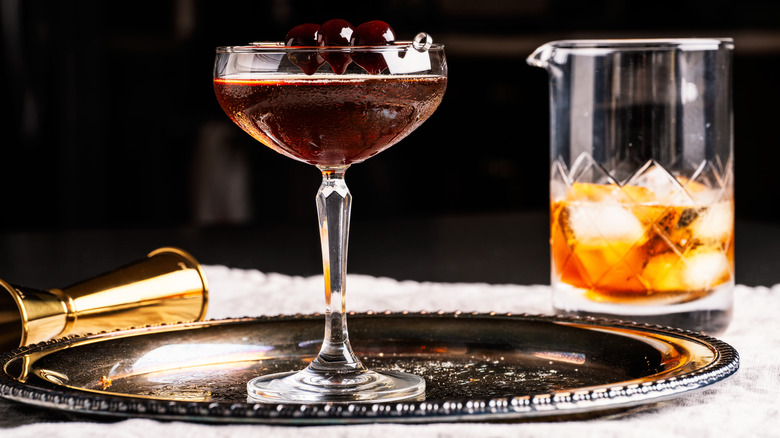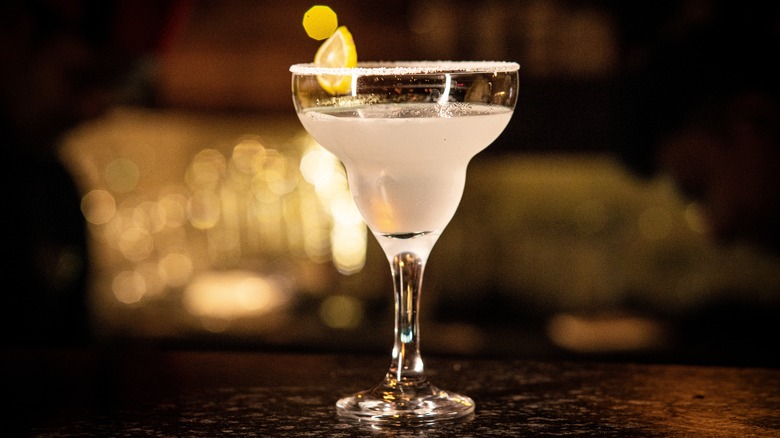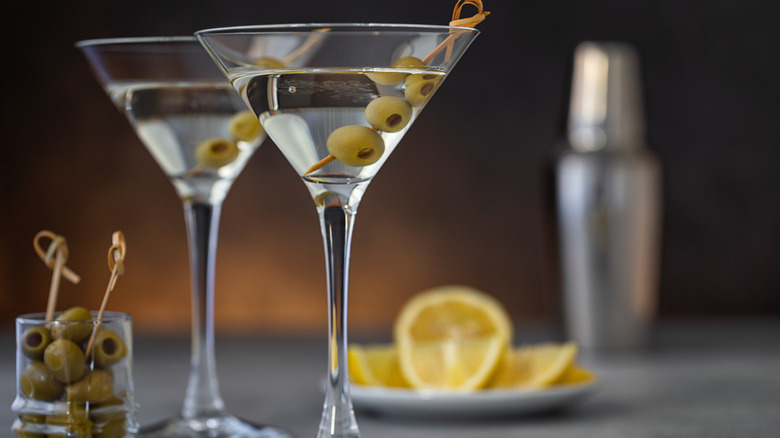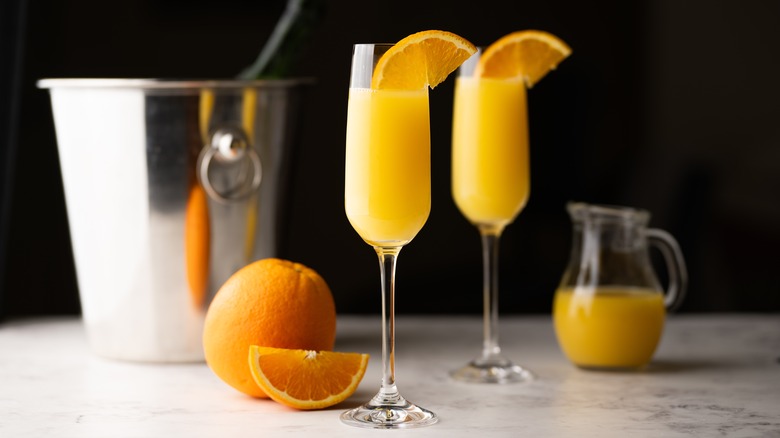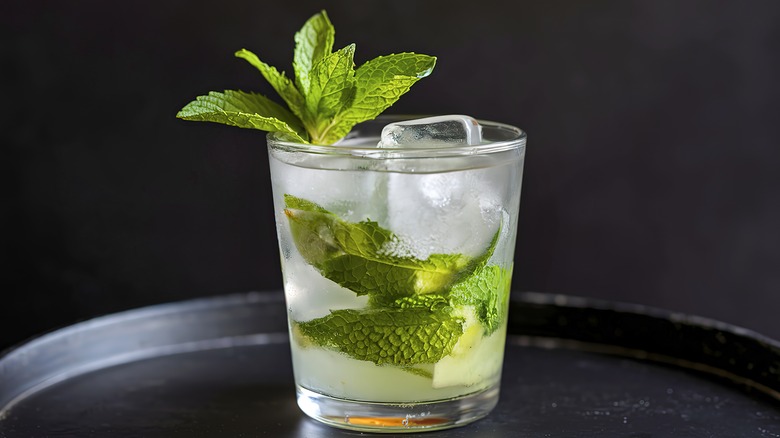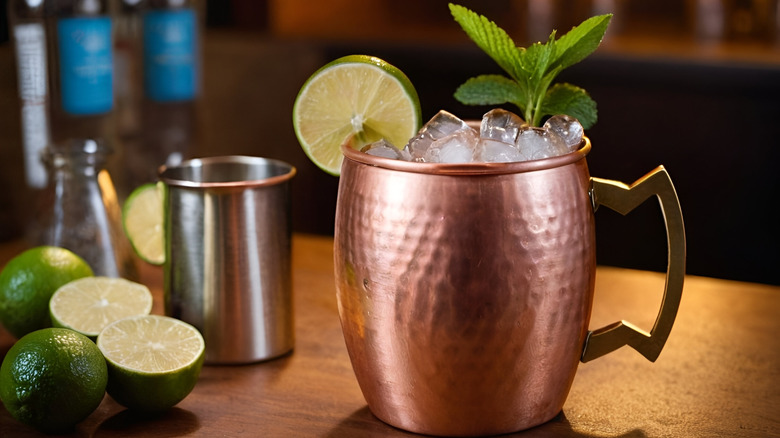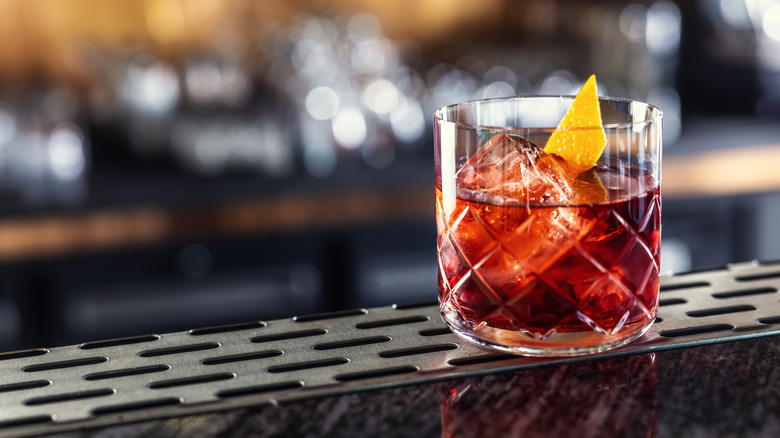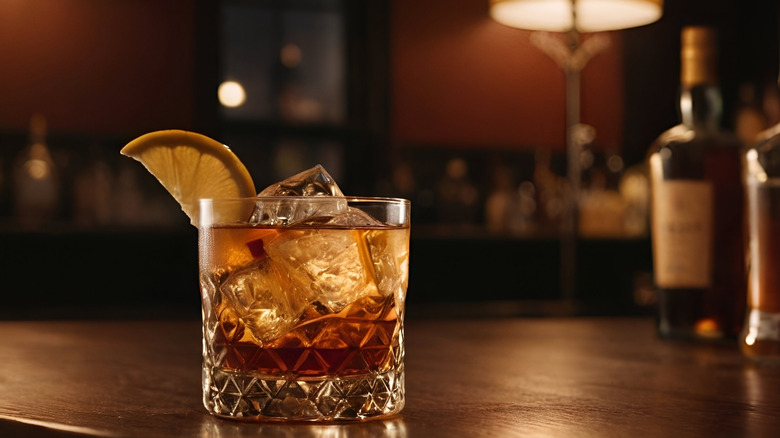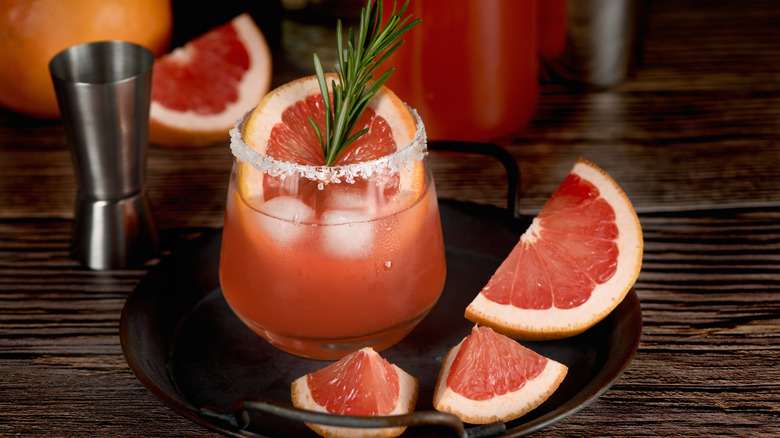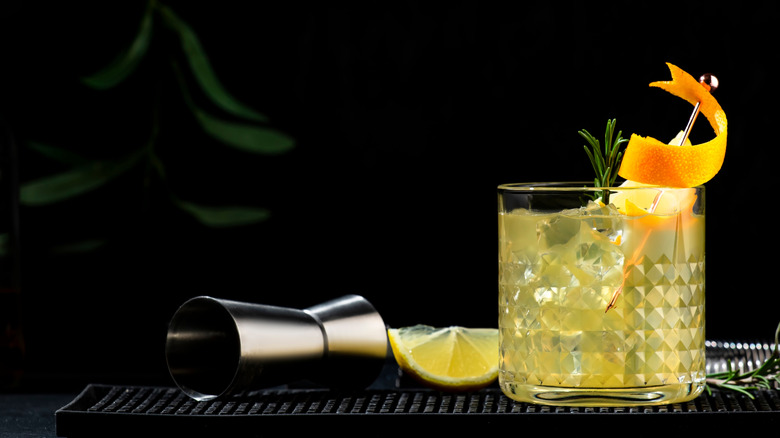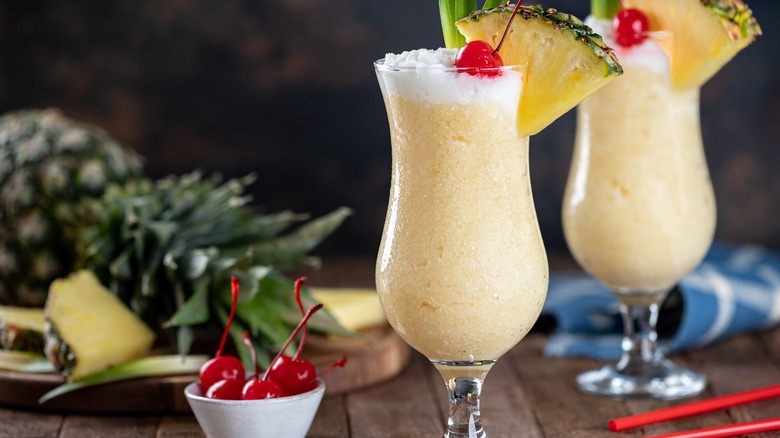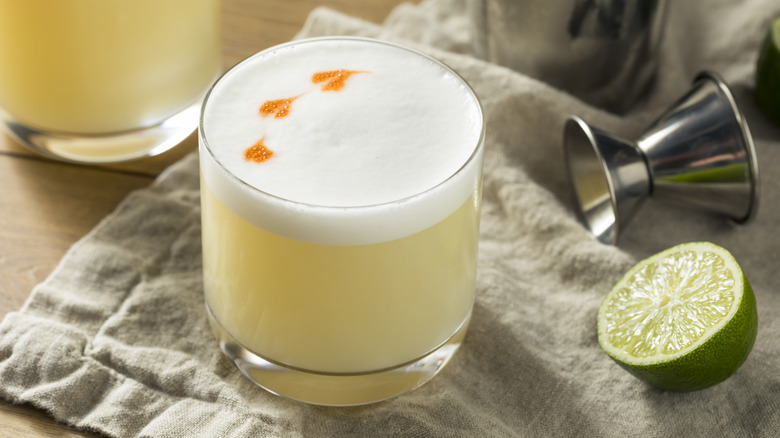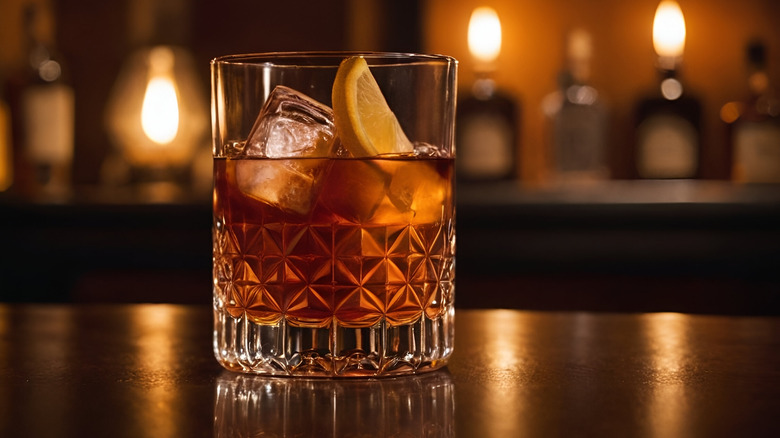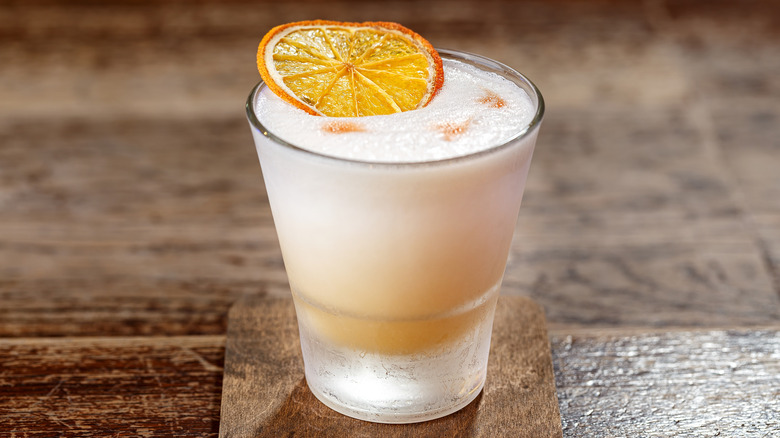The 25 Most Popular Cocktails Of All Time, Explained
The idea of popularity in any field is, of course, subjective and always fluctuating — particularly in the food and beverage space — based on a variety of factors including financial and regional preferences. However, as a former bartender in New York, having a multitude of friends and colleagues in the bar industry, and being a consummate cocktail consumer myself, I have an informed opinion about an essential list of popular cocktails in this current moment.
Cocktails continue to be an ever-present part of dining and dating culture, and I find them endlessly fascinating — how they're made, who orders them and for what occasions, and how the best bartenders are continuing to innovate and update the field. As evidenced by the "50 Best" Awards that inspire conversation (and argument) every year, I'm not alone in contemplating who is mixing the best — and most popular — cocktails.
While by no means is this a comprehensive list, it's based on conversations with in-the-know cocktail aficionados and my own personal taste and observations. I look forward to revisiting all of these drinks over the months to come, and spending time savoring each one!
1. Aperol Spritz
It may seem counterintuitive to start this list with a somewhat controversial pick, but you can't deny the appeal of an Aperol Spritz — especially if you're on holiday in Italy. Comprised of the spirit Aperol (known for its distinctive orange color and a taste that's both slightly bitter and citrusy), plus Prosecco and soda water, garnished with an orange slice, and served in a wine glass, the Aperol Spritz is frequently ordered as an aperitivo before dinner as it has a lower alcohol content and is refreshing. It's a light drink perfect for a summer day — or really, any time.
2. Bloody Mary
The classic brunch drink, with a mythology as a hangover cure, a typical Bloody Mary is made with vodka and tomato juice with a kick from something like Worcestershire sauce or horseradish. You can also add pepper, lime juice, or pickle juice for variation, and swap out the vodka for tequila or another spirit if you want a different flavor profile. Invented in the 1920s in Paris, this morning concoction has had true staying power, and is now on menus across the world with various garnishes such as bacon, shrimp, and even fried chicken.
3. Boulevardier
For those of us who aren't gin drinkers but love Negronis (further down on the list), the Boulevardier is a great option — it swaps bourbon for gin. This drink was also developed at the same bar in Paris where the Bloody Mary was birthed. (American Prohibition ironically launched more cocktails than it curbed.) The full ingredient list for a Boulevardier is simple: bourbon, sweet vermouth, and Campari (another bitter liquor with citrus notes), garnished ideally with an orange peel (although lemon will do, as well). You can serve in a coupe glass or with ice in a rocks glass.
4. Cosmopolitan
HBO's "Sex and the City" gave us so much: incredible fashion, honest conversations about dating, and of course, the Cosmopolitan (a "Cosmo" for short). Although this drink was around in the 1980s before the television show, Sarah Jessica Parker's Carrie Bradshaw re-popularized the cocktail for a generation of savvy women. Vodka based, cranberry juice gives it color, and an added dash of Cointreau or Grand Marnier with lime juice gives it a bit of sour to balance the sweet. Typically, there's also a lemon rind twist or a lime slice and it's served up, in a martini glass.
5. Daiquiri
Although most people might think of the frozen version of a daiquiri that is best consumed on a beach, a classic daiquiri is much cleaner and simpler: rum, lime juice, and sugar or simple syrup. Extremely popular in Cuba (the recipe was recorded by an American engineer working in Cuba in the late 1800s), Ernest Hemingway further popularized the drink when he was living there and slinging them back with an unmatched frequency. The next time you're considering one of the overpriced slushies offered on a resort menu, try the old school, more literary version, instead.
6. Dark 'n' Stormy
As you might intuit from the name, this is a drink that is popular with sailors and the boating community, becoming the "unofficial drink" of Bermuda where it was created by Bermuda's Royal Naval Officer's Club. The story goes that some Club members added rum to their ginger beer, creating a floater on top that looked like a storm cloud. The drink is similar to a Moscow Mule (also on the list), but uses dark rum instead of vodka. In addition to the rum and ginger beer, try garnishing with a lime or even candied ginger, if it's handy!
7. Espresso Martini
The Espresso Martini has officially made a comeback from the 80s and 90s. Forbes reported in 2022 that the cocktail was one of the best-selling cocktails in the U.S., jumping up five spots on the top seller list. When you want your caffeine and alcohol in equal parts, this should be your go-to. Most of the Espresso Martinis you'll find on a menu are vodka-based (although I personally prefer to swap out Mezcal for a smokier taste), and add in a coffee liqueur, a shot of espresso, and some kind of additional sweetener to make it an after-dinner or dessert drink.
8. French 75
Although the name sounds elegant, the French 75 has its origins in war. The French 75 was the common name for a gun used by the French in the first World War. It seems there were comparisons drawn between the powerful weapon and its namesake drink. As times have changed so have some of the ingredients of the French 75, but what has remained is gin, Champagne, lemon juice, and a sweetener like simple syrup. You'll commonly see this drink in a champagne flute with a lemon twist, as well.
9. Gimlet
The Gimlet is a close cousin of the Daiquiri — it has only three ingredients: gin, lime juice, and sugar. One theory about the origin of this drink was helping sailors get their vitamins. During a nasty outbreak of scurvy in the late 1880s, Rear-Admiral Sir Thomas Gimlette encouraged his crewmen to drink their lime juice to combat the disease — and add liquor to help wash it down. Even if you're not looking for a dose of vitamins, this drink is surprisingly refreshing, even today. Garnish with a lime wheel — if you squint, it could look like a ship's helm.
10. Long Island Iced Tea
Yes, it has a bad reputation for being the drink of choice for college students and bachelorette parties everywhere. But its high alcohol content is why it remains steadfastly popular. First, we should be clear that the drink has no iced tea in it — the name refers more to the color, which comes from a mix of lemon juice and cola. There is some dispute about whether the cocktail originated in Long Island, New York or a section of Tennessee. But either way, the five alcoholic ingredients are the same: gin, rum, tequila, triple sec, and vodka.
11. Mai Tai
If you're a fan of tiki bars, you've probably enjoyed a Mai Tai at some point. You also wouldn't be alone — this classic drink has been popular with politicians (Richard Nixon) and entertainers (Elvis). It mixes two rums — one light, one dark — with orgeat (an almond flavored cocktail syrup), lime juice, orange liqueur (Grand Marnier, for example), and a simple syrup. Some recipes will call for a rum float, however, I prefer the cocktail blended so it's not as liquor forward. You can also add lime and mint to garnish, and some bars may also put a pineapple slice in.
12. Manhattan
I would be remiss not to mention this is my personal favorite cocktail here. I've enjoyed variations on the Manhattan all over New York and around the world, and it's always a reliable drink to start or end the evening. Anecdotally, this cocktail was developed at the Manhattan Club in New York, although for whom is in dispute (Winston Churchill's mother is one theory). The Manhattan is made with two parts bourbon or rye to one part sweet vermouth and a dash of bitters. A brandied cherry for garnish is also one of my favorite components of this drink.
13. Margarita
Even the best Mexican food doesn't feel like a complete meal without a Margarita. A basic Margarita is relatively simple: tequila, orange liqueur (commonly Triple Sec), and lime juice, with a lime wedge garnish and optional salted rim. (This is another cocktail I personally swap mezcal for tequila.) Likely enjoyed in the 1930s under different names, a recipe for the Margarita appeared in "Esquire" magazine in the 1950s. Several different people claim credit for the invention, from all across Mexico and at various bars and parties. Whatever the origins, the Margarita has now become ubiquitous, particularly on Taco Tuesdays.
14. Martini (Classic)
Okay, this is my second favorite cocktail on the list. What a Manhattan does for me in the winter, the Classic Martini provides in the warmer months. Dirty (with an olive and/or olive juice) or with a lemon twist, the Martini is traditionally made with gin (although I prefer vodka), and as James Bond has taught us, it can be shaken or stirred — with dry vermouth. For the most perfect version of a Martini, make sure to use a chilled Martini glass, too. Some bars have been throwing in a dash of bitters, but I prefer mine without.
15. Mimosa
Another classic brunch drink has made the list, and it's deliciously simple, only consisting of two ingredients: orange juice and champagne. A fun piece of bartender lore says the filmmaker Alfred Hitchcock is the one to have invented this drink in San Francisco, while most acknowledge that the drink was created by a bartender at the Ritz in Paris as far back as the 1920s. You can change out the juice if you're not an orange fan, however, if you use peach purée that technically would make the drink a variation called a Bellini.
16. Mojito
We're back to a refreshing rum-based drink with the Mojito, which has additional components building on the Daiquiri. For a Mojito, you want to combine white rum, muddled mint, lime juice, simple syrup, and club soda. The Mojito originated in Havana when Sir Francis Drake landed in Cuba to plunder the city. While his mission was unsuccessful, some say a drink called the Draque was left behind — either created by Drake himself, or named in Havana to commemorate his visit. The Draque used a cane spirit that was replaced in the 1800s with Bacardi, and the name changed, as well.
17. Moscow Mule
If you're a keen barware observer, you've likely encountered the Moscow Mule and its distinctive copper mug, which keeps the cocktail very chilled. (The mug is not an essential component; think of it like a fancy garnish.) This cocktail traditionally combines vodka, lime juice, and ginger beer, garnished with a lime. It was created in Los Angeles in the 1940s as part of a marketing campaign for vodka, although contemporary variations of the drink include a Mezcal Mule and a Kentucky Mule, which uses bourbon.
18. Negroni
Many well-respected bartenders cite the Negroni as their favorite drink to make or drink, particularly at the end of the night. It's the definition of a classic, having inadvertently been invented in Florence in the early 20th century by a man named Count Camillo Negroni when he asked to replace soda water with gin in an Americano. We covered the Boulevardier earlier, but the original Negroni uses gin, Campari, sweet vermouth, and an orange peel. Many variations exist, swapping out the base liquor or types of vermouth, but the classic Negroni will always be a staple of cocktail menus.
19. Old Fashioned
One of the oldest cocktails on this list is the eponymous Old Fashioned. It's also one of the best known and easiest to make, with just whiskey (often bourbon or rye), sugar, and bitters as the ingredients. The drink dates back as far as the 1700s, when it was simply known as the Whiskey Cocktail. Although deceivingly easy to make, a proper Old Fashioned should be well-balanced, so none of the individual components are so overpowering. Bartenders continue to play around, sometimes adding additional fruit or swapping out the base liquor, but the original stands the test of time.
20. Paloma
Another choice to order at your favorite Mexican restaurant, the Paloma is just as loved as the Margarita as a tequila-based cocktail — it's the national drink of Mexico. The Paloma is usually served in a highball glass (where it is also constructed), and has tequila, grapefruit soda, and lime juice. I've enjoyed a variation on the Paloma where actual grapefruit juice is swapped for the soda, as well. A dash of salt can be added to the mix or to the rim, if it's your preference to have a more savory taste balance the sweet.
21. Penicillin
The Penicillin has become a modern classic, thanks to the popular New York bar, Milk and Honey. In the early 2000s, bartender Sam Ross was riffing on another cocktail, and mixed together blended scotch, lemon, and honey-ginger syrup, with a float of smoky scotch on top. Because it was developed by a top tier barman, this cocktail is more complicated to make at home (due to having to make the honey-ginger syrup), but it's certainly not impossible. Better yet, order it at your favorite local cocktail bar where they may have other variations or even candied ginger on offer.
22. Piña Colada
You know a cocktail has reached icon status when a song is dedicated to it. This frozen, blended drink comes to us from a bartender working in Puerto Rico in the 1950s, becoming the official drink of the country in 1978. The standard Piña Colada has rum, cream of coconut, and pineapple juice, all mixed together in a blender with ice. Additional components could include coconut milk, lime juice, and ... more (dark) rum, along with a maraschino cherry, and pineapple garnish. This is my vacation drink of choice, and when done right, is creamy, cold, and the right amount of boozy.
23. Pisco Sour
I've encountered the Pisco Sour in South America, where it certainly is considered a popular cocktail. It's believed to have been created by an American in Peru who wanted an alternative to the Whiskey Sour in the early 1900s. Pisco is a Peruvian or Chilean fruity spirit made from distilled grape juice. The current recipe for a Pisco Sour calls for Pisco, egg white, bitters, lime juice, and simple syrup. Ideally, the ingredients should be shaken together without ice first and garnished with the bitters on top of the egg foam.
24. Sazerac
You can't mention a Sazerac without also talking about New Orleans, where it exists as the official city cocktail and even has a hotel bar named after it (the Sazerac Bar in the Roosevelt Hotel. Antoine Amédée Peychaud, a pharmacist, created bitters in New Orleans as a curative, and began mixing it with brandy and the other Sazerac components. The modern Sazerac is very much like the aforementioned Old Fashioned, except a true Sazerac includes absinthe along with whiskey, bitters, and sugar. Absinthe isn't available in every bar, but if you can find it, this is one must-try cocktail.
25. Whiskey Sour
The final cocktail on this list is both straightforward and elevated, which is likely why it's so popular with drinkers. Essentially similar to the Pisco Sour, discussed earlier, the Whiskey Sour contains whiskey, lemon juice, simple syrup, and egg white, with the ingredients mixed without ice before being poured. (Many bars will skip the egg white, but the foam makes it more traditional.) More recently, some bars will add a red wine float, turning it into a New York or Greenwich Sour. You can add a maraschino cherry or orange and bitters on top as garnish.
